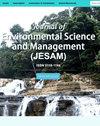Social Acceptability of the Bioremediation Technology for the Rehabilitation of an Abandoned Mined-Out Area in Mogpog, Marinduque, Philippines
IF 0.3
4区 环境科学与生态学
Q4 ENVIRONMENTAL SCIENCES
引用次数: 2
Abstract
Rehabilitation of mined-out areas poses great challenge because nutrients are depleted and conditions are not conducive for the conditions necessary for the growth and survival of plants. Proper combination of mycorrhizal fungi, nitrogen-fixing bacteria, compost, and lime to support the growth of trees in the poor soil has been discovered by the University of the Philippines Los Baños National Institute of Microbiology and Biotechnology. Having established a protocol using this formulation, a plant survival rate of 95% was achieved in a bioremediation project implemented by the Institute in a mined-out area in Capayang, Mogpog, Marinduque, Philippines. The social acceptance and adoption of this rehabilitation strategy was determined through a survey interview in the study area with the use of questionnaire. Six factors and nine variables were considered in the assessment. The bioremediation technology was acceptable to the community as indicated by the high percentage of respondents who gave an overall positive response (90%) and who were willing to adopt and recommend it for implementation in other mined-out areas (90%). Binary logistic regression showed that income and distance of residence from the rehabilitation site significantly influenced the respondents’ decision to accept the technology. Future bioremediation initiatives should also consider the participation and acceptance of stakeholders to ensure sustainability. Indigenous and endemic planting materials should be used in rehabiliation.菲律宾马林杜克Mogpog废弃采空区生物修复技术的社会接受度
采空区的恢复是一个巨大的挑战,因为营养物质已经耗尽,而且条件不利于植物生长和生存所需的条件。菲律宾洛斯巴尼奥斯大学国家微生物和生物技术研究所发现,菌根真菌、固氮细菌、堆肥和石灰的适当组合可以支持树木在贫瘠的土壤中生长。在使用该配方制定了一项方案后,该研究所在菲律宾Marinduque Mogpog Capayang的一个雷区实施的生物修复项目中,植物存活率达到了95%。通过在研究区域使用问卷进行调查访谈,确定了社会对这种康复策略的接受和采用情况。评估中考虑了六个因素和九个变量。生物修复技术为社区所接受,总体上给予积极回应的受访者比例很高(90%),愿意采用并建议在其他雷区实施生物修复技术(90%)。二元逻辑回归显示,收入和离康复地点的居住距离显著影响受访者接受该技术的决定。未来的生物修复举措还应考虑利益攸关方的参与和接受,以确保可持续性。恢复工作应使用当地和地方性种植材料。
本文章由计算机程序翻译,如有差异,请以英文原文为准。
求助全文
约1分钟内获得全文
求助全文
来源期刊

Journal of Environmental Science and Management
ENVIRONMENTAL SCIENCES-
CiteScore
0.90
自引率
0.00%
发文量
10
审稿时长
2 months
期刊介绍:
The Journal of Environmental Science and Management (JESAM) is an international scientific journal produced semi-annually by the University of the Philippines Los Baños (UPLB).
JESAM gives particular premium to manuscript submissions that employ integrated methods resulting to analyses that provide new insights in environmental science, particularly in the areas of:
environmental planning and management;
protected areas development, planning, and management;
community-based resources management;
environmental chemistry and toxicology;
environmental restoration;
social theory and environment; and
environmental security and management.
 求助内容:
求助内容: 应助结果提醒方式:
应助结果提醒方式:


